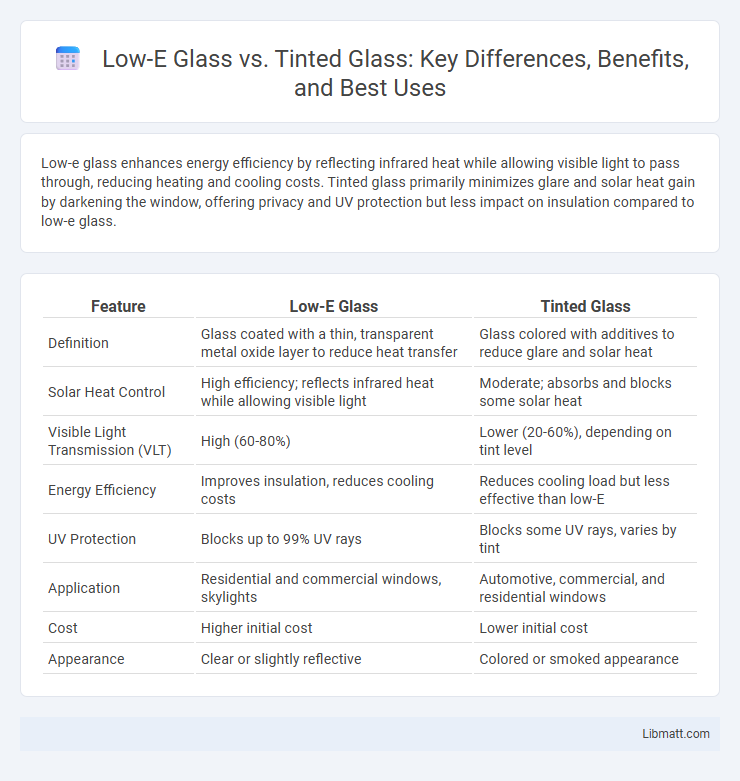Low-e glass enhances energy efficiency by reflecting infrared heat while allowing visible light to pass through, reducing heating and cooling costs. Tinted glass primarily minimizes glare and solar heat gain by darkening the window, offering privacy and UV protection but less impact on insulation compared to low-e glass.
Table of Comparison
| Feature | Low-E Glass | Tinted Glass |
|---|---|---|
| Definition | Glass coated with a thin, transparent metal oxide layer to reduce heat transfer | Glass colored with additives to reduce glare and solar heat |
| Solar Heat Control | High efficiency; reflects infrared heat while allowing visible light | Moderate; absorbs and blocks some solar heat |
| Visible Light Transmission (VLT) | High (60-80%) | Lower (20-60%), depending on tint level |
| Energy Efficiency | Improves insulation, reduces cooling costs | Reduces cooling load but less effective than low-E |
| UV Protection | Blocks up to 99% UV rays | Blocks some UV rays, varies by tint |
| Application | Residential and commercial windows, skylights | Automotive, commercial, and residential windows |
| Cost | Higher initial cost | Lower initial cost |
| Appearance | Clear or slightly reflective | Colored or smoked appearance |
Introduction to Low-E Glass and Tinted Glass
Low-E glass features a microscopically thin coating that reflects infrared energy while allowing visible light to pass through, enhancing energy efficiency by minimizing heat transfer indoors. Tinted glass incorporates color pigments to reduce glare and solar heat gain by absorbing and filtering sunlight, offering a darker appearance. Both types improve building comfort and energy performance but differ in their technology and impact on natural light transmission.
How Low-E Glass Works
Low-E glass features a microscopically thin, transparent coating that reflects infrared heat while allowing visible light to pass through, improving energy efficiency by reducing heat transfer. Unlike tinted glass, which absorbs and darkens sunlight, Low-E glass selectively blocks ultraviolet and infrared rays without significantly reducing natural light. Your home benefits from better temperature regulation and lower energy bills due to the advanced thermal insulation properties of Low-E glass.
How Tinted Glass Functions
Tinted glass reduces solar heat gain by absorbing a portion of sunlight, which lowers indoor temperatures and reduces glare. Unlike low-e glass, which reflects infrared radiation using a thin metallic coating to improve energy efficiency, tinted glass primarily relies on its color to filter and block sunlight. Your choice between tinted and low-e glass depends on whether heat absorption or heat reflection better suits your energy-saving and comfort needs.
Energy Efficiency Comparison
Low-e glass significantly outperforms tinted glass in energy efficiency by reflecting up to 70% of infrared heat while allowing visible light, reducing HVAC costs. Tinted glass primarily blocks visible sunlight, reducing glare and some heat gain but offers limited thermal insulation compared to low-e coatings. Buildings with low-e glass show improved indoor comfort and lower energy consumption due to superior solar heat control and minimized heat loss during colder months.
UV Protection: Low-E vs. Tinted Glass
Low-E glass offers superior UV protection by reflecting up to 99% of harmful ultraviolet rays, significantly reducing fading and skin damage. Tinted glass provides moderate UV protection by absorbing some UV radiation but does not block as much UV light as Low-E glass. For optimal UV defense in windows, Low-E coatings are more effective than standard tinted glass.
Impact on Natural Light and Visibility
Low-e glass significantly enhances natural light transmission while minimizing solar heat gain and glare, maintaining clear visibility with minimal color distortion. Tinted glass reduces overall visible light entry, resulting in darker interiors and diminished visibility, especially under low-light conditions. Both options affect daylight impact differently, with low-e glass prioritizing energy efficiency and clarity, whereas tinted glass emphasizes shading and privacy.
Cost Differences and ROI
Low-e glass typically costs 20-30% more upfront than tinted glass due to its advanced coating technology that improves energy efficiency by reflecting infrared heat while allowing visible light. Despite higher initial costs, low-e glass offers better return on investment (ROI) through significant reductions in heating and cooling expenses, often recouping the premium within 3-5 years. Tinted glass provides lower upfront costs but yields less energy savings, leading to a longer payback period and diminished overall ROI in climate control applications.
Application Scenarios: Where Each Glass Excels
Low-e glass excels in residential and commercial buildings where energy efficiency and indoor climate control are priorities, reducing heat transfer and UV radiation while maintaining natural light. Tinted glass performs best in automotive windows, sunrooms, and facades requiring glare reduction and enhanced privacy by filtering sunlight and lowering visible light transmission. Both types offer UV protection, but low-e glass specifically targets thermal insulation, while tinted glass primarily manages solar heat gain and aesthetics.
Aesthetic Considerations and Design Options
Low-e glass offers a sleek, clear appearance that preserves natural light while enhancing energy efficiency, making it ideal for modern, minimalist designs. Tinted glass provides a range of colors and shading options, allowing for creative control over aesthetics and privacy but may reduce visible light transmission. Your choice depends on whether you prioritize maintaining natural brightness or achieving a specific visual tone and ambiance in your space.
Choosing the Right Glass for Your Needs
Low-e glass offers superior energy efficiency by reflecting infrared heat while allowing visible light, making it ideal for climates requiring temperature control. Tinted glass reduces glare and enhances privacy by absorbing sunlight but may diminish natural light and visibility. Selecting the right glass depends on priorities like energy savings, glare reduction, privacy, and aesthetic preferences.
low-e glass vs tinted glass Infographic

 libmatt.com
libmatt.com